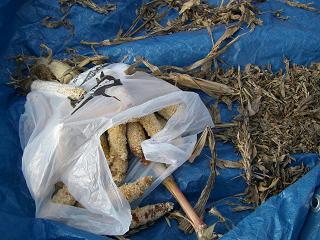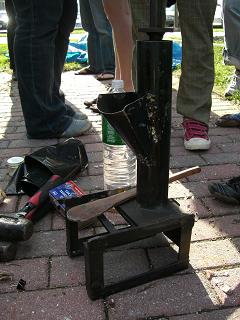Fuel from the Fields: MIT Charcoal Project by Mitra L. '07
a "simple and affordable solution" to charcoal production in Haiti, 21 pictures
From the article “Engineering changes for the better in Haiti: Local activist joins up with MIT instructor”
By Ron Fletcher
The Boston Globe
June 5, 2005
Smith’s ”genius” for designing simple and affordable solutions to the fundamental, seemingly intractable problems that plague impoverished regions earned her a place among the 2004 MacArthur fellows.
”Usually a degree in engineering means you’ll eventually be working on cars or bombs,” said Smith. ”I don’t drive a car, and I don’t kill people. The MIT mission statement talks about serving humanity. My students care about that. Gerthy cares about that. I care about that.”
I blogged in a previous entry about my taking Development Lab (D-Lab) with Amy Smith, and here’s just one example of a) how hands on the class is, and b) how it focuses on using technology to solve problems in developing nations.
We’re going to take these corn cobs and corn husks

and this briquette press

to make charcoal

Read on, grasshopper….
What is charcoal?
Charcoal is the product of incomplete combustion of organic matter. This occurs when the organic matter is heated in a low-oxygen environment, which causes the organic matter to be carbonized instead of burning away.





This piece of wood is a place-holder in the center of the barrel; eventually, we will pull it out and have a nice column of space for the fire.

Cassava root (manoika) is a locally-available material (meaning locally in Petite Anise, Haiti) that will serve (in porridge form) as a binder for the charcoal. This process was designed to be as efficient as possible, so we will boil the cassava using the heat from the fire in the barrel. Peel it,

grate it,


eat it?

Prop the barrel up on bricks

and light the bagasse

The metal rod here is holding up the pot of boiling cassava

Use sand to seal the edges

and let it carbonize for a while. Fast forward to the next step:

Put the carbonized material in a plastic bag,

add the binder, and mix.

Put the resulting material in the charcoal brick press,

hammer away,

and voila. Leave these bricks out to dry (in sunny weather, it takes a couple of days) and then they’re ready to use, at a fraction of the cost of purchased charcoal.


Good work, people.
wow! i’m amazed… when our school had gone to the villages for an IB Year 12 science project, we had examined the effeciency of a whole variety of local fuels in a village in Gujarat, India. Sounds reasonably similar to what we were trying to accomplish… we were trying to assess the use of appropriate technology versus high technology in the village… similar concept here, but at a whole new level… u actually created cheap fuel!!! well done!! Will be applying to MIT for Fall 2007!! This is really cool!!
Good short-term solution, but I think that it needs to go hand-in-hand with reforestation in order to solve Haiti’s energy woes. Thinking past the organic fuel phase, solar panels and wind energy might work especially well in Haiti, considering its tropical location and the constant temperature difference between the mainland and the ocean (creating constant winds). Perhaps MIT could work with an energy giant like GE to get a couple experimental renewable energy stations on the grid in Haiti. If anyone can do it, it’s you guys.
You cheated me !!!!!!!!!! I did the same, when i was in 10the grade, well well you should be paying me for stealing my idea or you can get off with something cheaper get me admission in MIT Fall 2007. But this isn’t good.
Hey Tim, you make a good point. This technique is actually part of a category of “appropriate technology”
From Wikipedia: Appropriate technology is technology that is most appropriate to the environment and culture it is intended to support. It is suitable for use in developing nations or underdeveloped rural areas of industrialized nations, which may lack the money and specialised expertise to operate and maintain high technology. In practice, it is often something that might be described as using the simplest and most benign level of technology that can effectively achieve the intended purpose in a particular location.
http://en.wikipedia.org/wiki/Appropriate_technology